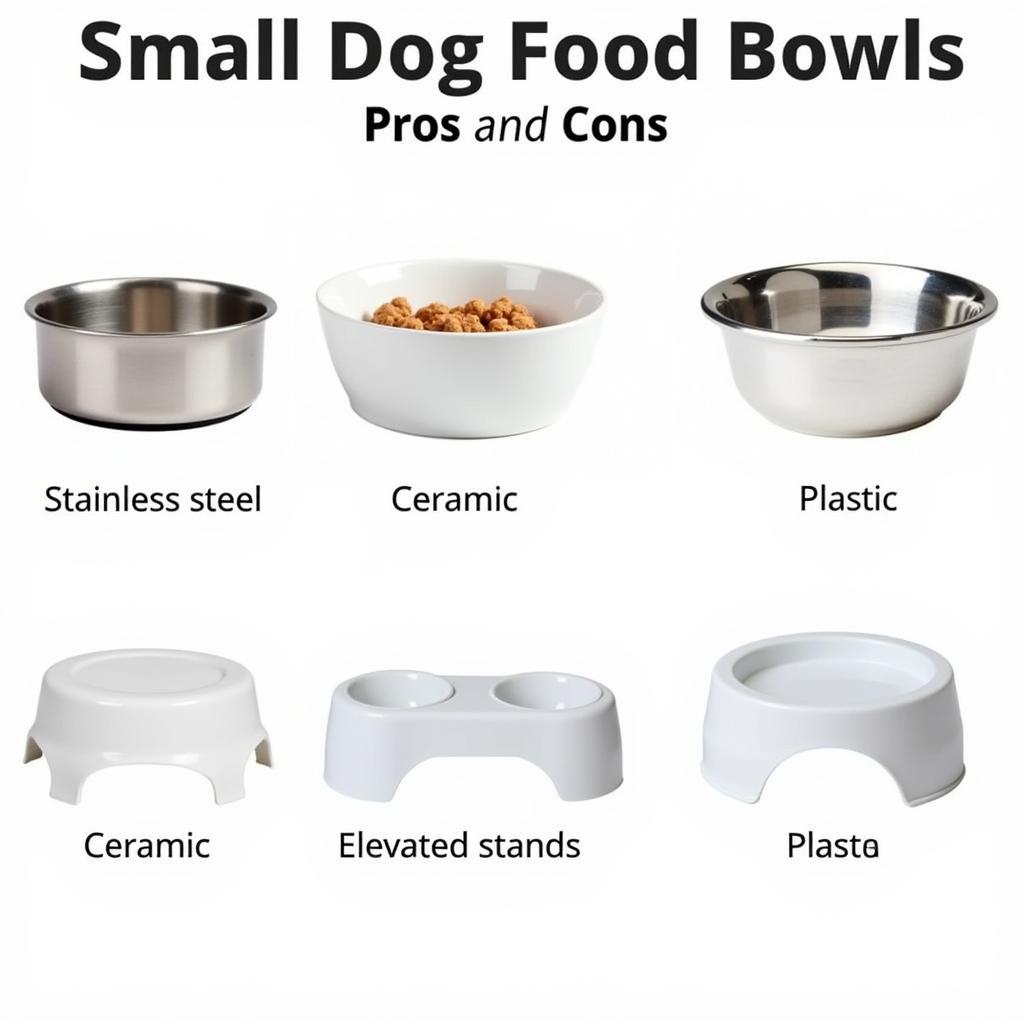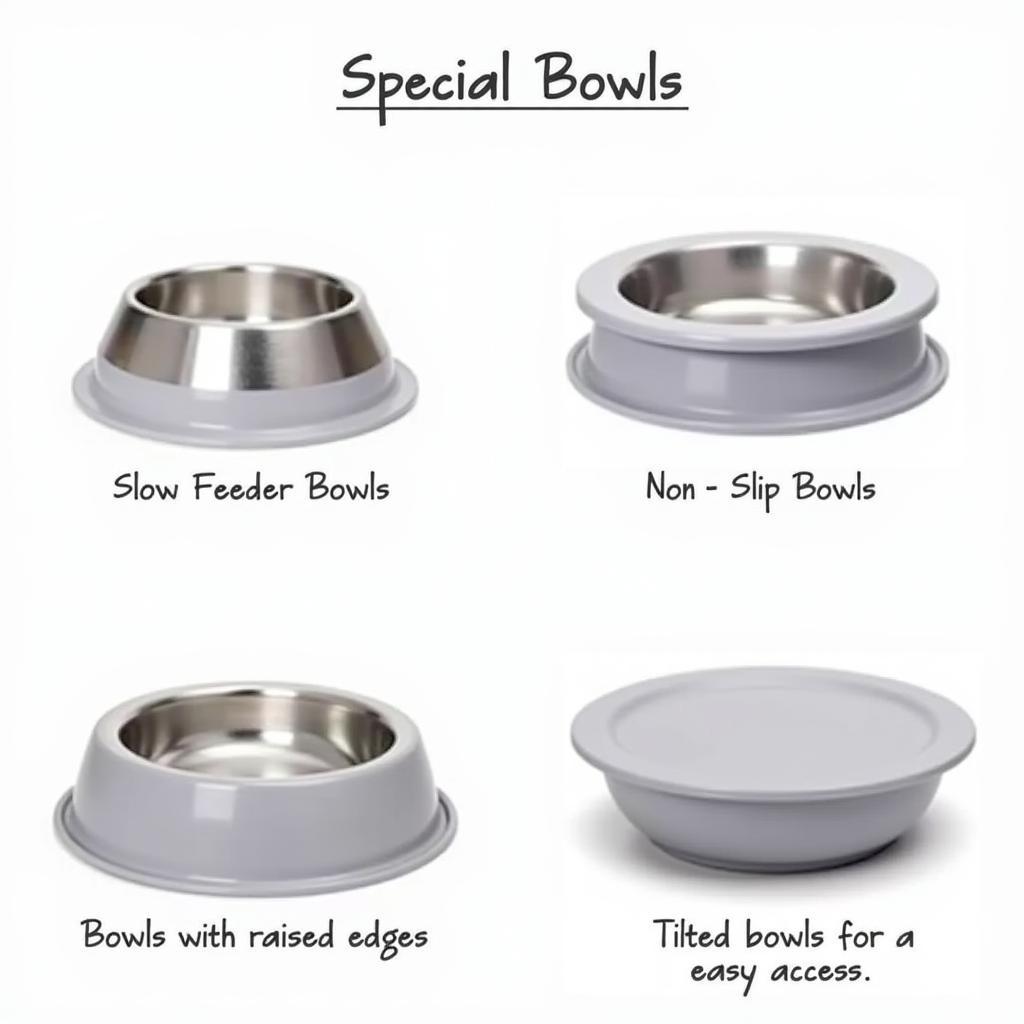Small dog breeds have unique needs, and their food bowls are no exception. Finding the right Small Dog Food Bowls can significantly impact your furry friend’s mealtime experience and overall well-being. From size and material to design and features, selecting the perfect bowl involves considering various factors.
Choosing the right small dog food bowl isn’t as simple as grabbing the smallest one on the shelf. Factors like your dog’s breed, eating habits, and potential health issues all play a role. For example, a bowl that’s too deep can be challenging for a short-nosed breed like a Pug, while a raised bowl might benefit an older dog with arthritis. Choosing the right bowl can transform mealtime from a struggle into a comfortable and enjoyable experience for your small companion. What’s more, the perfect small dog food bowl can even help prevent health problems and promote better digestion. If you’re looking to upgrade your dog’s dining experience, explore the best food topper for picky dogs to enhance their meals.
Size Matters When Choosing Small Dog Food Bowls
One of the most crucial factors to consider is the size of the bowl. It should be proportionate to your dog’s size and food intake. A bowl that’s too large can be overwhelming, while one that’s too small will require frequent refills. Consider a small, shallow dish that allows your dog to reach the food easily without straining their neck or whiskering against the sides. For larger small breeds, like a Miniature Schnauzer, you might need a slightly bigger bowl than for a tiny Chihuahua.
What’s the ideal capacity for small dog food bowls? While it depends on your dog’s individual needs, a general guideline is to choose a bowl that can comfortably hold one to two cups of food. This will ensure your dog gets enough food without overfilling the bowl.
Material Matters: What Are Small Dog Food Bowls Made Of?
Small dog food bowls are available in a wide variety of materials, each with its own pros and cons. Stainless steel is a popular choice due to its durability, ease of cleaning, and resistance to bacteria. Ceramic bowls are another great option, offering a stylish aesthetic and dishwasher-safe convenience. However, they can be prone to chipping. Plastic bowls are lightweight and affordable, but they may not be as durable as other materials. If your dog is a powerful chewer, you might want to consider a more robust material. Check out our dog food processor for convenient meal preparation.
For dogs prone to allergies, stainless steel is often the best choice, as it’s non-porous and hypoallergenic. If you prefer the aesthetic appeal of ceramic, opt for lead-free and food-grade options.
 Different Materials for Small Dog Food Bowls
Different Materials for Small Dog Food Bowls
Elevated or Ground Level: Finding the Right Height for Small Dog Food Bowls
The height of your dog’s food bowl can also play a significant role in their comfort and digestion. Elevated dog food bowls are particularly beneficial for senior dogs or those with mobility issues, as they reduce strain on the neck and joints. For small breeds, a slightly raised bowl can make mealtime easier and more enjoyable. However, for puppies or dogs with certain health conditions, ground-level bowls might be more suitable.
“Elevated bowls are a game-changer for senior dogs,” says Dr. Emily Carter, a veterinarian specializing in canine geriatric care. “They can significantly improve digestion and reduce the risk of bloat, particularly in small breeds prone to these issues.” A raised platform can help reduce back strain and encourages better posture while eating. Consider the labrador food bowl for its thoughtful design.
Design and Features: Making Mealtime Fun and Functional
Beyond the basics, several design features can enhance your small dog’s mealtime experience. Slow feeder bowls are a great option for dogs who tend to gulp down their food too quickly, promoting healthier eating habits. Non-slip bowls prevent spills and messes, while bowls with cute designs can add a touch of personality to your pet’s dining area. Thinking about how to best organize your feeding space? Look into dog food and water bowl mats to keep things tidy.
“For picky eaters, try using a shallow, wide bowl. This allows the aroma of the food to spread, making it more enticing,” advises Amelia Grant, a certified pet nutritionist. “And for dogs prone to making a mess, a bowl with a lip or rim can help contain spills.”
 Small Dog Food Bowls with Special Features
Small Dog Food Bowls with Special Features
Conclusion: The Perfect Small Dog Food Bowl Awaits
Choosing the right small dog food bowls can significantly enhance your furry friend’s mealtime experience. By considering your dog’s individual needs and the various factors discussed above, you can find the perfect bowl to promote their health, happiness, and overall well-being. Selecting the right small dog food bowls is an important step in ensuring your small dog’s health and happiness. A well-chosen bowl can improve digestion, reduce mess, and make mealtimes more enjoyable for your pet. Looking for a convenient way to store and dispense food? Consider a wall mount dog food dispenser.
FAQs
- What size bowl is best for a Chihuahua? A very small, shallow bowl is ideal.
- Are elevated bowls good for all small dogs? They can be beneficial for senior dogs or those with mobility issues but may not be suitable for all.
- What’s the best material for small dog food bowls? Stainless steel is durable, easy to clean, and hypoallergenic.
- How can I prevent my dog from eating too fast? Consider a slow feeder bowl.
- Are ceramic bowls safe for dogs? Yes, as long as they are lead-free and food-grade.
- What are the benefits of using a mat under the food bowls? They help contain spills and keep the feeding area clean.
- Can I put small dog food bowls in the dishwasher? Stainless steel and some ceramic bowls are dishwasher-safe, but always check the manufacturer’s instructions.
For further assistance, contact us at Phone Number: 02437655121, Email: minacones@gmail.com Or visit us at: 3PGH+8R9, ĐT70A, thôn Trung, Bắc Từ Liêm, Hà Nội, Việt Nam. We have a 24/7 customer service team.